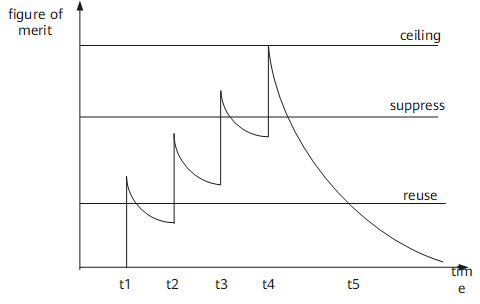Transmission Alarm Processing
Transmission alarms are processed as follows:
After a transmission device generates alarms, it determines whether to report the alarms to its connected IP device based on the alarm types.
If the alarms are b1tca, b2tca, b3tca, sdbere, or sfbere, the transmission device determines whether the alarm threshold is reached.
If the threshold is reached, the transmission device reports the alarms to the IP devices for processing.
If the threshold is not reached, the transmission device ignores these alarms.
For all other alarms, they are directly reported to the IP device for processing.
If the recording function is enabled on the IP device, the alarms are recorded.
The IP device determines whether to change the physical status of the interface based on customized alarm types.
If no alarm types are customized to affect the physical status of the interface, these alarms are ignored. The physical status of the interface remains unchanged.
If an alarm type is customized to affect the physical status of the interface, the alarm is processed based on the transmission alarm customization mechanism.
Transmission Alarm Customization Mechanism
When a transmission device reports alarm signals to an IP device, the IP device determines whether to change the physical status of its interface based on the transmission alarm customization function.
- When a certain type of alarms is customized to affect the interface status but transmission alarm filtering or suppression is not configured:
The physical status of the interface changes to Down if such an alarm is generated
The physical status of the interface changes to Up if such an alarm is cleared.
- If a certain type of alarms is customized to affect the interface status and transmission alarm filtering or suppression is configured, the IP device processes the alarm according to the filtering mechanism or suppression parameters.
Transmission Alarm Filtering Mechanism
Transmission alarm filtering enables an IP device to determine whether an alarm signal is a burr.
If the interval between an alarm signal generation and clearance is smaller than the filtering timer value, this alarm signal is considered a burr.
If the alarm signal is a burr, it is ignored. The physical status of the interface remains unchanged.
If the alarm signal is not a burr:
The physical status of the interface changes to Down if the signal is an alarm generation signal.
The physical status of the interface changes to Up if the signal is an alarm clearance signal that is not suppressed.
Transmission Alarm Suppression Mechanism
Transmission alarm suppression enables an IP device to determine how to process an alarm signal.
When an alarm's figure of merit is smaller than suppress:
If no alarm generation or clearance signal is received, figure of merit decreases with time.
If an alarm generation signal is received, the physical status of the interface changes to Down, and figure of merit increases by the penalty value.
If an alarm clearance signal is received, the physical status of the interface changes to Up, and figure of merit decreases exponentially.
When an alarm's figure of merit reaches suppress, this alarm is suppressed. The generation or clearance signal of this alarm does not affect the physical status of the interface.
When an alarm is frequently generated, figure of merit reaches ceiling. It does not increase even if new alarm signals arrive. If no alarm signals arrive, figure of merit decreases with time.
When an alarm's figure of merit decreases to reuse, this alarm is free from suppression.
After the alarm is free from suppression, the process repeats if this alarm is generated again.
Figure 1 shows the correlation between a transmission device sending alarm generation signals and how figure of merit increases and decreases.
At t1 and t2, figure of merit is smaller than suppress. Therefore, alarm signals generated at t1 and t2 affect the physical status of the interface, and the physical status of the interface changes to Down.
At t3, figure of merit exceeds suppress, and the alarm is suppressed. The physical status of the interface is not affected, even if new alarm signals arrive.
At t4, figure of merit reaches ceiling. If new alarm signals arrive, figure of merit is recalculated but does not exceed ceiling.
At t5, figure of merit falls below reuse, and the alarm is free from suppression.
